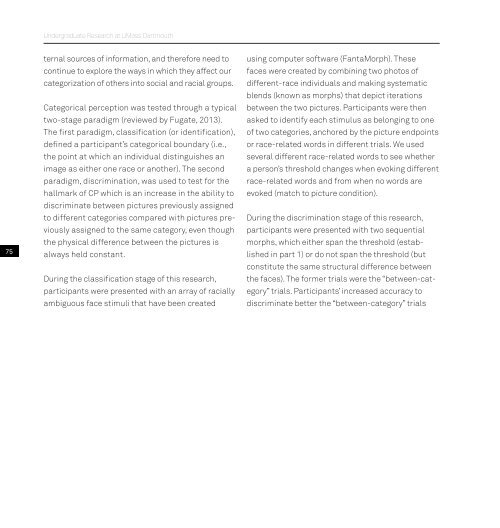Undergrad_Book_16-18_Pge_View_Print_no print marks_compressed
Create successful ePaper yourself
Turn your PDF publications into a flip-book with our unique Google optimized e-Paper software.
<strong>Undergrad</strong>uate Research at UMass Dartmouth<br />
75<br />
ternal sources of information, and therefore need to<br />
continue to explore the ways in which they affect our<br />
categorization of others into social and racial groups.<br />
Categorical perception was tested through a typical<br />
two-stage paradigm (reviewed by Fugate, 2013).<br />
The first paradigm, classification (or identification),<br />
defined a participant’s categorical boundary (i.e.,<br />
the point at which an individual distinguishes an<br />
image as either one race or a<strong>no</strong>ther). The second<br />
paradigm, discrimination, was used to test for the<br />
hallmark of CP which is an increase in the ability to<br />
discriminate between pictures previously assigned<br />
to different categories compared with pictures previously<br />
assigned to the same category, even though<br />
the physical difference between the pictures is<br />
always held constant.<br />
During the classification stage of this research,<br />
participants were presented with an array of racially<br />
ambiguous face stimuli that have been created<br />
using computer software (FantaMorph). These<br />
faces were created by combining two photos of<br />
different-race individuals and making systematic<br />
blends (k<strong>no</strong>wn as morphs) that depict iterations<br />
between the two pictures. Participants were then<br />
asked to identify each stimulus as belonging to one<br />
of two categories, anchored by the picture endpoints<br />
or race-related words in different trials. We used<br />
several different race-related words to see whether<br />
a person’s threshold changes when evoking different<br />
race-related words and from when <strong>no</strong> words are<br />
evoked (match to picture condition).<br />
During the discrimination stage of this research,<br />
participants were presented with two sequential<br />
morphs, which either span the threshold (established<br />
in part 1) or do <strong>no</strong>t span the threshold (but<br />
constitute the same structural difference between<br />
the faces). The former trials were the “between-category”<br />
trials. Participants’ increased accuracy to<br />
discriminate better the “between-category” trials



